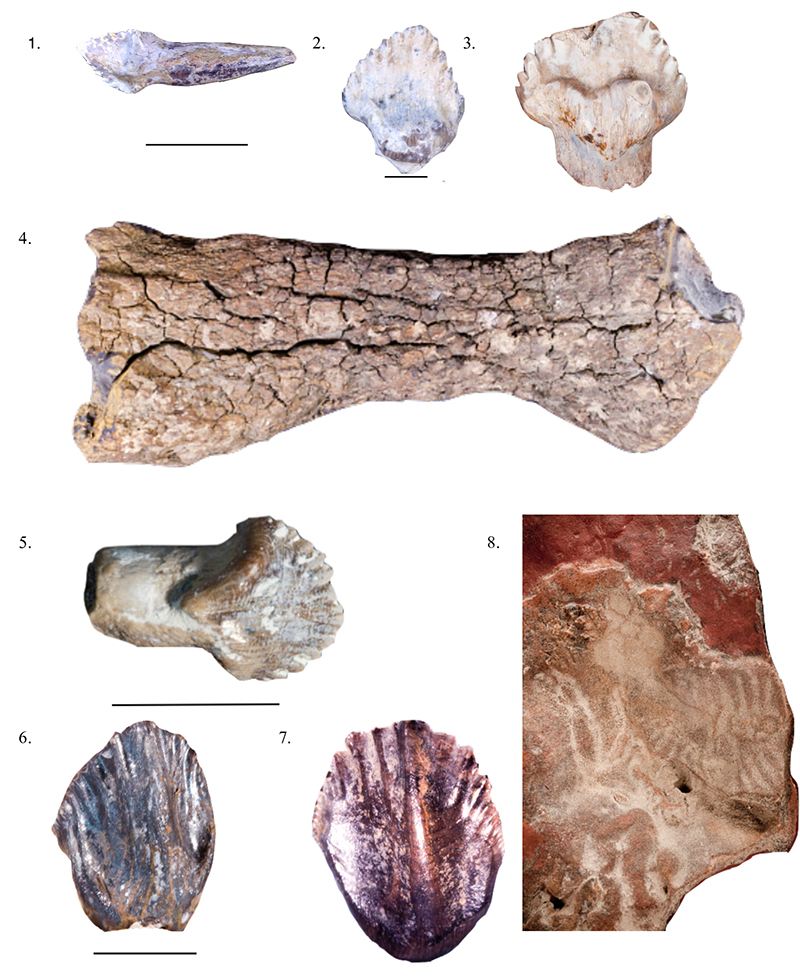FIGURE 1. Selected carcharodontosaur elements from the Arundel Clay. Holotype tooth of “Allosaurus” medius (1), teeth assigned to Acrocanthosaurus (2-4), and a manual ungual possibly assignable to the latter allosaur in ?lateral (5) view. Scale bar equals 10 mm (1-4), scale bar equals 254 mm (5). Courtesy of the Smithsonian Institution. Photos by M. Brett-Surman.

FIGURE 2. Selected elements of dromaeosaurs from the Arundel Clay. Teeth of Deinonychus sp. (1-4), claw of Coelurus gracilis (5). Scale bar equals 10 mm (1-4), scale bar equals 100 mm (5). Courtesy of the Smithsonian Institution. Photos by M. Brett-Surman.

FIGURE 3. Selected ornithomimosaur remains from the Arundel Clay. Proximal tibia in medial (1) view, distal end of metatarsal III in lateral (2) view, left pedal phalanges II-1 in dorsolateral (3-4) view, pedal phalanx III-2 in dorsal (5) view, pedal ungual USNM6107 in medial (6) view. Scale bar equals 10 mm (1-2), 100 mm (3), 50 mm (4-6), 19.05 mm. Courtesy of the Smithsonian Institution. Photos by M. Brett-Surman.

FIGURE 4. Selected elements of Astrodon johnstoni. Teeth (1), mandible with teeth in lateral view (2), femur in dorsal view (3) and humerus in ventral (4) view. All scale bars equal 50 mm. Courtesy of the Smithsonian Institution. Photos by M. Brett-Surman and B. Martin.

FIGURE 5. Selected elements of Arundel Clay and Patuxent facies ornithischians. Teeth and tibia of Priconodon crassus (1-5), teeth of an indeterminate neoceratopsian (6-7), and the holotype of Propanoplosaurus (8). Scale bar equals 50 mm (1, 4); equals 5 mm (2-3, 5, 6-7). (H) not to scale. Courtesy of the Smithsonian Institution. Photos by M. Brett-Surman, G. R. King, and C. Clark.

FIGURE 6. Indeterminate tyrannosauroid metatarsal in dorsal (1), ventral (2), lateral (3), medial (4), proximal (5), and distal (6) views. Scale bars equal 100 mm. Courtesy of the Division of Vertebrate Paleontology; YPM VPPU.016760, Peabody Museum of Natural History,Yale University, New Haven, Connecticut, USA; peabody.yale.edu. Photography by Jamie Henderson.

FIGURE 7. Originally designated holotype of Hypsibema crassicauda. Lectotype caudal vertebra of Hypsibema crassicauda (1), distal tyrannosauroid femur (=?Dryptosaurus aquilunguis) (2), hadrosauroid metatarsal II and limb shaft (3). Scale bar equals 100 mm. Assignments after Baird and Horner (1979). Courtesy of the Smithsonian Institution. Photo by M. Brett-Surman.

FIGURE 8. Approximate locations of non-avian dinosaur provinces of Appalachia superimposed on the landmass after Gallagher (1993), Carpenter et al. (1995), Schwimmer (1997), Schwimmer et al. (2015), and this paper. Atlantic Coastal Plain province indicated in aquamarine, Carolina Abbreviations: Kg., Kanguk Formation; Mt., Marshalltown Formation; Th.-Cm., Tar Heel-Coachman equivalent formations; Mc.-Bt.-Cs.-Gs., Mooreville Chalk-Blufftown-Coffee Sand-“Glenallen” Sand equivalent formations. Red circle indicates the ?Northern Appalachian province; aquamarine circle indicates the Atlantic Coastal Plain province; green circle indicates Carolinian province; orange circle indicates Gulf Coastal Plain province; purple circle indicates Western Appalachian province. Map courtesy Ron Blakey (https://deeptimemaps.com/).


